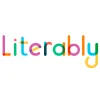Take a look inside 5 images
Literably
Pros: Gives teachers more time to focus on instruction and intervention.
Cons: Students may have challenges with handling the microphone or being understood. Text selection is fairly limited for each assessment.
Bottom Line: Some districts may find this to be a cost-effective, time-saving option for reading records.
Conducting reading-fluency assessments is a common approach to getting concrete feedback about an important aspect of your students' reading ability. If you don't already, set aside a regular, weekly time to assess progress in reading accuracy, expression, and speed. Even without multiple devices, a digital tool like Literably can be a big help in coordinating so many assessments. Set up one (or a few) classroom computers as assessment stations -- students can cycle through and record during different class activities, as you see fit (independent or group work, SSR, etc.). Literably will automatically score students' reading, but teachers should look in detail at the results and listen to students' audio to spot-check accuracy and fidelity.
The tool is easy enough to use that most students probably won't need extra support after an initial session or two. While there aren't reading selections for students above a 7th-grade level, the tool could still be useful for older students who need remediated reading support, especially ELLs.
Literably is a tool for tracking and assessing students' reading fluency. There's an iOS app as well as a web version. The overall process is relatively simple. Teachers assign readings to students who then use their device's microphone to record themselves reading the text aloud. Literably scores each recording, sending data and feedback to the teacher. There are more than 50 reading selections spanning grades K-7, most excerpted from Creative Commons-licensed work or the public domain, or with permission from publishing partners. Literably offers a PDF chart outlining grade-level correlations with a variety of other well-known reading level systems (Reading Recovery, Fountas & Pinnell, DRA, Basal, and Lexile).
As students progress, teachers can select an option for automatic leveling based on performance, or they can manually level each student. Reports include bar graphs with both current and past results, including word count per minute, accuracy to 100 percent, and error and self-correction rates. In addition to the original audio recordings, teachers can access a text copy of each reading, with students' omissions and additions (marked in red) and miscues, noted line by line in the margin.
For teachers looking to measure and track students' reading fluency, Literably can be a very useful tool. Side-by-side, full-week bar graphs give key information at a glance. Most notably, the site streamlines a previously time- and labor-intensive process, while also helping to manage reports throughout the year. At the time of review, students' reading performance is scored manually by the Literably staff; turnaround is reasonably prompt -- within about one day. Usefully, teachers can listen to students' audio themselves and double-check the assessment. Comprehension questions are aligned to Common Core standards, and teachers can have students complete an open-ended question and grade it themselves, creating a chance for conferencing and feedback once students have completed the assessment.
Some teachers may want to observe students during the assessment. Literably has an option for this, but ultimately the tool is designed to save time by letting students complete the assessment themselves.













